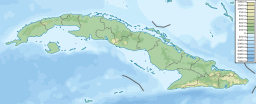Sierra Maestra facts for kids
Quick facts for kids Sierra Maestra |
|
|---|---|

Sierra Maestra near the border of Granma and Santiago de Cuba provinces.
|
|
| Highest point | |
| Peak | Pico Turquino |
| Elevation | 1,974 m (6,476 ft) |
| Dimensions | |
| Length | 240 km (150 mi) |
| Width | 30 km (19 mi) |
| Geography | |
| Country | Cuba |
| Range coordinates | 20°0′0″N 76°45′0″W / 20.00000°N 76.75000°W |

The Sierra Maestra is a mountain range that runs westward across the south of the old Oriente Province in southeast Cuba, rising abruptly from the coast. The range falls mainly within the Santiago de Cuba and in Granma Provinces. Some view it as a series of connecting ranges (Vela, Santa Catalina, Quemado Grande, Daña Mariana), which join with others to the west. At 1,974 m (6,476 ft), Pico Turquino is the range's – and the country's – highest point. The area is rich in minerals, especially copper, manganese, chromium, and iron.
History
The Sierra Maestra has a long history of guerrilla warfare, starting with the resistance of the Taínos under Guamá (died 1532), the Cimarrón Neo-Taíno nations escaped slave cultures, the Ten Years' War (1868–1878) and the Cuban War of Independence (1895–1898), and various minor conflicts such as the Race War of 1912, and the uprisings of Antonio Guiteras (died 1935) against Gerardo Machado (President of Cuba from 1925 to 1933) and Fulgencio Batista (President 1940–1944 and 1952–1959). After Fidel Castro returned to Cuba in 1956 from exile in Mexico, he and the few other survivors from the failed 1953 attack on Moncada Barracks hid in the Sierra Maestra. There they succeeded in expanding their 26th of July Movement, starting a revolution throughout the region. They built up guerrilla columns, and in collaboration with other groups in the central provinces, Escopeteros on the foot-hills and plains, and the urban resistance, eventually overthrew Batista on 1 January 1959.
Ornithology
Calls of the Cuban subspecies of the ivory-billed woodpecker, now possibly extinct, were reported but not confirmed in the Sierra Maestra in 1998; it remains the most likely habitat to contain a population of the species. The mountain range also hosts a population of wintering Bicknell's thrushes.
See also
 In Spanish: Sierra Maestra para niños
In Spanish: Sierra Maestra para niños
- Geography of Cuba
- Turquino National Park


